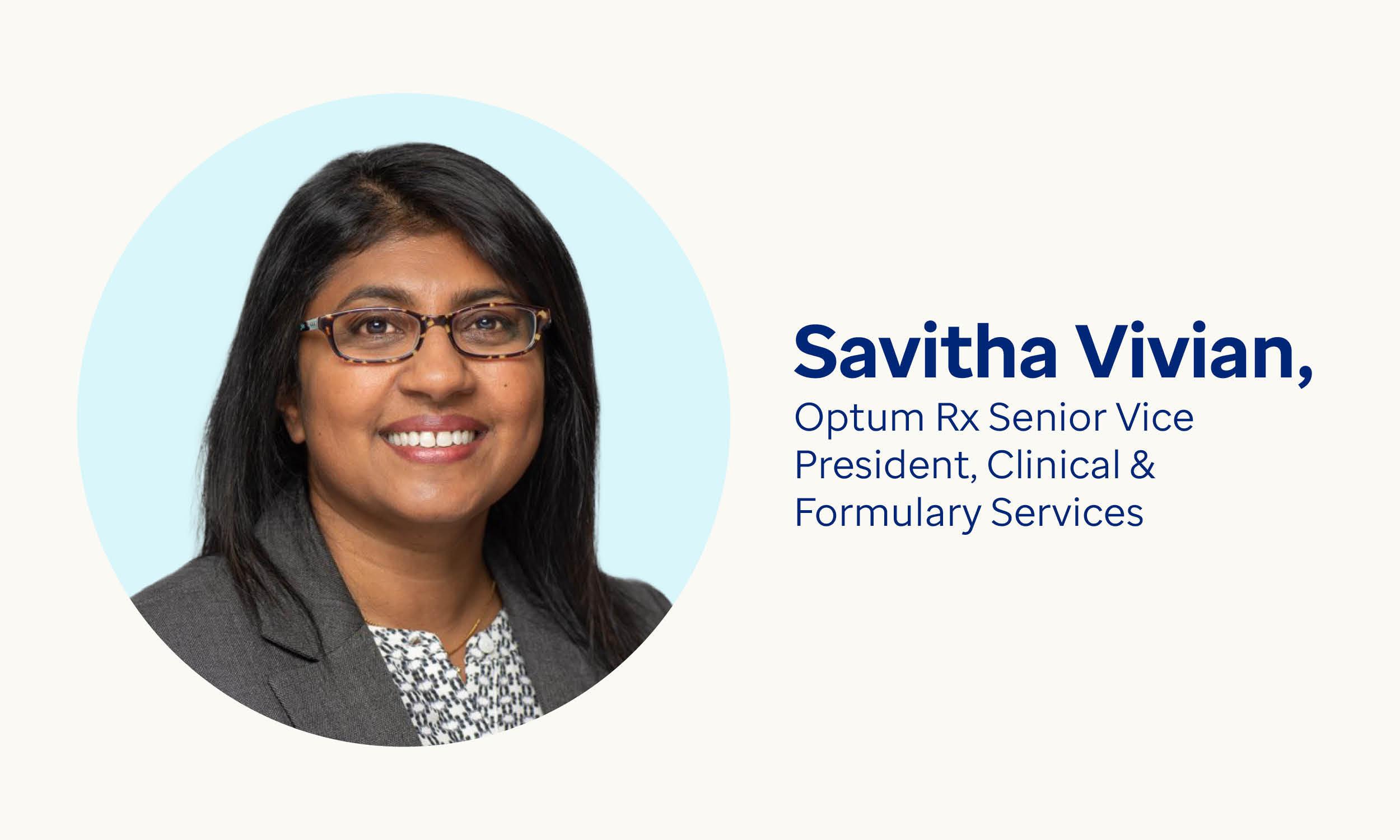Concerns about the rising cost burden of prescription medications represent a rare area of agreement across the health care sector.
In a recent study of plan sponsors, 90% said high drug prices are a threat to the affordability of employer-provided coverage.1 High-cost drugs also present affordability concerns for patients. Even though more than 90% of Americans have health insurance, half say they are only one illness away from financial trouble.2
High-cost drugs that offer little to no added clinical value over existing, less expensive alternatives are one of the leading drivers of rising costs. These drugs continue to enter the market and can cost hundreds as times as much as clinically appropriate alternatives.
The Optum Rx® Vigilant Drug Program™ addresses the challenge caused by these high-cost, low-value drugs. The program uses advanced analytics and dedicated market surveillance to identify these drugs. It then removes wasteful spending by shifting utilization to lower-cost drugs through exclusions.
How it works
The program uses advanced analytics and dedicated market surveillance to identify these drugs. Participating plan sponsors can then opt to exclude them from pharmacy benefits. As the chart below indicates, the Vigilant Drug Program is modular and makes use of several clinical quality and cost-savings strategies to achieve robust overall per member per month (PMPM) savings.
The program includes clinical quality strategies to drive clinical appropriateness and cost savings.
- New drugs to market strategy — Temporarily excludes newly launched products until they can be formally reviewed by the Optum Rx National Pharmacy & Therapeutics (P&T) Committee. This program is a standard component of our Premium Formulary. This helps minimize member disruption and decrease financial risk until P&T review is completed. These drugs accounted for 9% of PMPM savings in 2020.
- Clinical duplicates strategy — Excludes newer, more costly medications that offer no clinical advantage over existing medications with similar chemical composition and possible generic options. Examples include unique dosage forms, combinations of two or more available medications, unique strengths, certain delivery devices and multiple product kits/packages. These drugs accounted for 41% of PMPM savings.
- Non-essential strategy — Excludes select high-cost, non-FDA-approved products or those deemed unnecessary. Encourages use of lower-cost, FDA-approved options with established safety and effectiveness for the same condition(s). These drugs accounted for 32% of PMPM savings.
The program also includes cost-saving strategies to promote use of clinically equivalent, lower-cost options.
- High-cost brands with generics — Excludes select high-cost brand products when a lower-cost, therapeutically interchangeable generic product is available. This accounted for 4% of PMPM savings.
- High-cost generics — Excludes high-cost generics when lower-cost alternatives are available with the same active ingredients or belong to the same drug class. This accounted for 14% of PMPM savings.
Demonstrated savings
As high-cost medications continue to enter the market, the Vigilant Drug Program detects them and identifies alternatives. Participating plan sponsors can then opt to exclude them from pharmacy benefits.
Since it launched, the Vigilant Drug Program has saved plan sponsors a total of $1.5 billion.3 In 2020 alone, savings reached $754.3 million. As the number of medications covered by the program continues to grow, so do the savings. In 2020, the per member per month (PMPM) savings rose to $4.50, a 3% increase over 2019.4
Optum Rx Vigilant Drug Program PMPM savings by year
Yet, it is important to note that this PMPM figure represents an average. The Vigilant Drug Program is both optional and modular. Therefore, clients can choose different modules in various combinations based on the unique needs of their members. As a result, clients that opt to exclude more drugs will benefit from more savings. For example, clients electing each component of the Vigilant Drug Program saved $5.75 on a PMPM basis in 2020.5
The Vigilant Drug Program in action
Since drug makers continue to produce high-cost, low-value medicines, the list of products covered by the Vigilant Drug Program continues to expand.
Of the many drugs excluded by the Optum Rx Vigilant Drug Program few demonstrate the potential for savings more clearly than Pennsaid®. An anti-inflammatory drug applied topically to treat the pain of osteoarthritis of the knee, it costs 60 times more than a clinically appropriate generic alternative. Vigilant Drug Program savings on this drug alone totaled $13 million in 2020.
Another prime example of the drugs targeted by the program is Vimovo®. A brand oral medication used to treat symptoms of osteoarthritis and rheumatoid arthritis, Vimovo contains a combination of a nonsteroidal anti-inflammatory drug (NSAID) and a proton pump inhibitor (PPI) and has an ingredient cost of $2,377 per prescription. In comparison, clinically appropriate alternative NSAID drug naproxen costs $15 per prescription. Complementary alternative PPIs such as omeprazole and pantoprazole, commonly cost approximately $15. As a result, Vigilant Drug Program savings on Vimovo totaled $11 million in 2020.
Often, several high-cost, low-value drugs will flood a single drug class. This is the case with prescription prenatal vitamins that include similar combinations of vitamins and minerals as clinically comparable generic alternatives. The Vigilant Drug Program has identified low-cost replacements for several drugs in this class including Azesco®, Trinaz®, Genicin Vita-S®and Lorid®. These products can as much as $5,600 per prescription, compared with $44 for alternativities. This helps not only clients but also pregnant women who may have chosen to forego these products altogether due to cost concerns.
Likewise, the Vigilant Drug Program has identified a similar trend of high-priced prescription wound dressings. These products are used to manage wounds and scars resulting from burns, surgical procedures or other trauma. Consider SIL-K PAD® Silicone pads. Despite having similar ingredients as over the counter (OTC) and lower-cost generic products, this product can cost up to 125 times as much as alternatives.
A commitment to controlling costs
Optum Rx is unique in the resources it has dedicated to identifying and mitigating these types of wasteful spending.
“As drug costs continue to rise, proactive strategies such as the Vigilant Drug Program will only become more crucial,” says Savitha Vivian, senior vice president of clinical services, Optum Rx. “By empowering plan sponsors to combat the troubling trend of drug pricing misconduct, we are helping safeguard critical pharmacy benefit resources for drug therapies that provide meaningful clinical value.”
The Vigilant Drug Program is a prime example of how Optum Rx is protecting clients and members against rising costs. To learn more, please reach out to your Optum Rx representative.
Related content

Drug pricing spotlight: Wound care

Don't Pay 5000% More for Commonly Available Generic Drugs

5 questions: Premium Value formulary
Sources
- National Alliance of Healthcare Purchaser Coalitions. Pulse of the purchaser survey. September 2020 results. Accessed April 1, 2021.
- The Physicians Foundation. 2019 Survey of America’s patients. Published 2019. Accessed April 1, 2021.
- Optum® internal data. Vigilant Drug Scorecard. Feb. 2021
- Ibid.
- Ibid.
STATEMENT REGARDING FINANCIAL INFLUENCE:
This article is directed solely to its intended audience about important developments affecting the pharmacy benefits business. It is not intended to promote the use of any drug mentioned in the article and neither the author nor Optum Rx has accepted any form of compensation for the preparation or distribution of this article.
